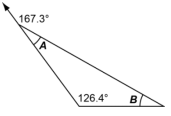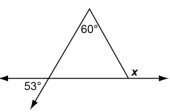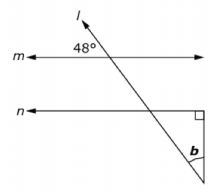Clusters should not be sorted from Major to Supporting and then taught in that order. To do so would strip the coherence of the mathematical ideas and miss the opportunity to enhance the major work of the grade with the supporting clusters.
- Assessment Limits :
Items must not include shapes beyond triangles
- Calculator :
Neutral
- Context :
No context
- Test Item #: Sample Item 1
- Question:
What is the measure of
 , in degrees, in the figure shown?
, in degrees, in the figure shown?
- Difficulty: N/A
- Type: EE: Equation Editor
- Test Item #: Sample Item 2
- Question:
What is the measure of
 , in degrees, in the figure shown?
, in degrees, in the figure shown?
- Difficulty: N/A
- Type: EE: Equation Editor
- Test Item #: Sample Item 3
- Question:
Two similar triangles are shown.

What is the measure of
 , in degrees?
, in degrees? - Difficulty: N/A
- Type: EE: Equation Editor
- Test Item #: Sample Item 4
- Question:
A figure with parallel lines m and n is shown.

What is the measure, in degrees, of
 ?
? - Difficulty: N/A
- Type: EE: Equation Editor
Related Courses
Related Access Points
Related Resources
Educational Software / Tool
Formative Assessments
Image/Photograph
Lesson Plans
Problem-Solving Tasks
Student Center Activity
Tutorials
MFAS Formative Assessments
Students are asked to describe and justify the relationship between corresponding angles and alternate interior angles.
Students are asked to apply the Exterior Angle of a Triangle Theorem and provide an informal justification.
Students are asked to provide an informal justification of the Triangle Sum Theorem.
Students are asked to describe and justify the relationship between same side interior angles.
Students are asked to write an informal justification of the AA Similarity Theorem.
Student Resources
Educational Software / Tool
This resource is an online glossary to find the meaning of math terms. Students can also use the online glossary to find words that are related to the word typed in the search box. For example: Type in "transversal" and 11 other terms will come up. Click on one of those terms and its meaning is displayed.
Type: Educational Software / Tool
Problem-Solving Tasks
Students use interior and exterior angles to to verify attributes of an octagon and square. Students are given a tile pattern involving congruent regular octagons and squares.
Type: Problem-Solving Task
Use informal arguments to establish facts about the angle sum and exterior angle of triangles, about the angles created when parallel lines are cut by a transversal, and the angle-angle criterion for similarity of triangles.
Type: Problem-Solving Task
This task provides students the opportunity to see how the mathematical ideas embedded in the standards and clusters mature over time. The task uses facts about supplementary, complementary, vertical, adjacent, and alternate interior angles in a multi-step problem to write and solve simple equations for an unknown angle in a figure. It is a good introduction to writing paragraphs, 2-column, and/or flow chart proofs.
Type: Problem-Solving Task
This task is ideally suited for instruction purposes where students can take their time and develop several of the standards, as the mathematical content is directly related to, but somewhat exceeds, the content of the standard on sums of angles in triangles. Careful analysis of the angles requires students to construct valid arguments using abstract and quantitative reasoning. Producing the picture in part (c) helps students identify a common mathematical argument repeated multiple times. Students may use pattern blocks to develop the intuition for decomposing the hexagon into triangles.
Type: Problem-Solving Task
Student Center Activity
Students can practice answering mathematics questions on a variety of topics. With an account, students can save their work and send it to their teacher when complete.
Type: Student Center Activity
Tutorials
In this video, we find missing angle measures from a variety of examples.
Type: Tutorial
In this tutorial, students are asked to prove two angles congruent when given limited information. Students need to have a foundation of parallel lines, transversals and triangles before viewing this video.
Type: Tutorial
This video gives the proof of sum of measures of angles in a triangle. This video is beneficial for both Algebra and Geometry students.
Type: Tutorial
Parent Resources
Educational Software / Tool
This resource is an online glossary to find the meaning of math terms. Students can also use the online glossary to find words that are related to the word typed in the search box. For example: Type in "transversal" and 11 other terms will come up. Click on one of those terms and its meaning is displayed.
Type: Educational Software / Tool
Problem-Solving Tasks
Students use interior and exterior angles to to verify attributes of an octagon and square. Students are given a tile pattern involving congruent regular octagons and squares.
Type: Problem-Solving Task
Use informal arguments to establish facts about the angle sum and exterior angle of triangles, about the angles created when parallel lines are cut by a transversal, and the angle-angle criterion for similarity of triangles.
Type: Problem-Solving Task
This task provides students the opportunity to see how the mathematical ideas embedded in the standards and clusters mature over time. The task uses facts about supplementary, complementary, vertical, adjacent, and alternate interior angles in a multi-step problem to write and solve simple equations for an unknown angle in a figure. It is a good introduction to writing paragraphs, 2-column, and/or flow chart proofs.
Type: Problem-Solving Task
This task is ideally suited for instruction purposes where students can take their time and develop several of the standards, as the mathematical content is directly related to, but somewhat exceeds, the content of the standard on sums of angles in triangles. Careful analysis of the angles requires students to construct valid arguments using abstract and quantitative reasoning. Producing the picture in part (c) helps students identify a common mathematical argument repeated multiple times. Students may use pattern blocks to develop the intuition for decomposing the hexagon into triangles.
Type: Problem-Solving Task









